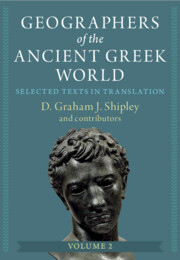Book contents
- Frontmatter
- Dedication
- Epigraph
- Contents
- PART IV: Roman Period
- 22 Juba II of Mauretania
- 23 Isidoros of Charax
- 24 Pseudo-Aristotle, On the Cosmos (De mundo)
- 25 Pseudo-Arrian, Circumnavigation of the Erythraian Sea
- 26 Pseudo-Plutarch, On the Names of Rivers and Mountains and the Things in them
- 27 Arrian of Nikomedeia, Circumnavigation of the Euxine
- 28 Dionysios Periegetes
- 29 Agathemeros son of Orthon
- 30 Dionysios of Byzantion
- 31 Pseudo-Hippolytos, Stadiasmos (Stade Table or Circumnavigation of the Great Sea)
- PART V: Late Antique Period
- Sources of Extracts (Selected)
- Works Cited
- Concordances
- Selective Index
25 - Pseudo-Arrian, Circumnavigation of the Erythraian Sea
from PART IV: - Roman Period
Published online by Cambridge University Press: 25 March 2024
- Frontmatter
- Dedication
- Epigraph
- Contents
- PART IV: Roman Period
- 22 Juba II of Mauretania
- 23 Isidoros of Charax
- 24 Pseudo-Aristotle, On the Cosmos (De mundo)
- 25 Pseudo-Arrian, Circumnavigation of the Erythraian Sea
- 26 Pseudo-Plutarch, On the Names of Rivers and Mountains and the Things in them
- 27 Arrian of Nikomedeia, Circumnavigation of the Euxine
- 28 Dionysios Periegetes
- 29 Agathemeros son of Orthon
- 30 Dionysios of Byzantion
- 31 Pseudo-Hippolytos, Stadiasmos (Stade Table or Circumnavigation of the Great Sea)
- PART V: Late Antique Period
- Sources of Extracts (Selected)
- Works Cited
- Concordances
- Selective Index
Summary
This chapter presents a new, annotated translation of the Circumnavigation of the Erythraian Sea (commonly known by the Latin title Periplus maris Erythraei or PME). Erroneously attributed to Arrian (see Chapter 27 of this volume), it was probably written in the 1st century AD, a generation or two before he was active, by a Greek-speaker from Egypt. The chapter introduction shows how the work is unlike any other that we have, in being a detailed overview of regions east of Egypt from the point of view of an experienced trader (possibly the Sosandros named by Markianos in Chapter 34), though also drawing upon a variety of written sources of disparate character. Consequently, we are presented with a combination of navigational information, useful to those commissioning or planning trade voyages, with enlivening facts such as marvels (paradoxa) that signify to the reader that its author is an educated man. He had perhaps been recruited to write a handbook for merchants, at a time when Roman naval presence in the Red Sea and Indian Ocean was increasing. Most famously, the work contains a plethora of information about specific commodities traded in the Red Sea and Indian Ocean, exports from particular ports, and where those goods originated. A detailed map shows many of the ports mentioned in the text, while another clarifies the relationship between the prevailing winds of the Indian Ocean and the maritime itineraries described.
- Type
- Chapter
- Information
- Geographers of the Ancient Greek WorldSelected Texts in Translation, pp. 684 - 709Publisher: Cambridge University PressPrint publication year: 2024



